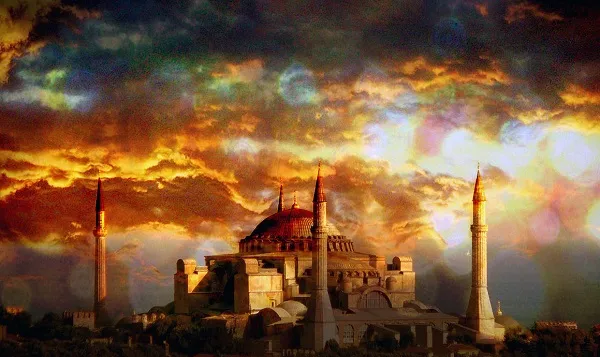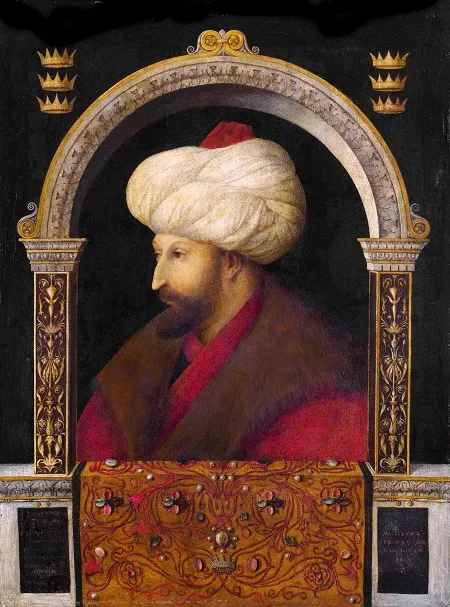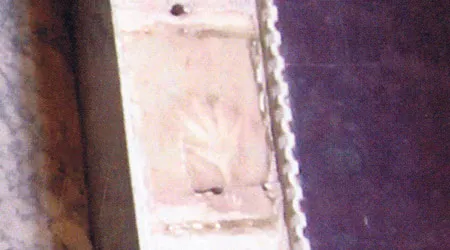
HAGIA SOPHIA
It is one of the most important monuments of the world architectural history, which is an important place in the art world in terms of architecture, magnificence, size and functionality.
Holy wisdom
Hagia Sophia, which is the largest church in the East Roman Empire built in Istanbul and built three times in the same place and which means "Sacred Wisdom", served as the cathedral as the greatest church of the capital, which was occupied by monarchs throughout the Byzantine Empire from the Vth century.
Third Hagia Sophia
After two churches built in the same place and destroyed by various factors, the present day Hagia Sophia was built by the Emperor Justinianos (527-565), two important architects of the time, Miletos (Miletos) Isidoros and Trallesli (Aydın) Anthemios. According to the historian Prokopios, the construction started on 23 February 532 and was completed in a short period of 5 years, and the church worship was opened with a ceremony on 27 December 537.
Adorned with the finest architectural pieces
Emperor Justinianos ordered Hagia Sophia to be confiscated for use in the Hagia Sophia by sending news to all his provinces to make it more spectacular and spectacular. The columns and marbles used in this structure; Aspendos, Ephesus, Baalbek, Tarsus were brought from the ancient city of Anatolia and Syria.
Gold and silver mosaics
All surfaces outside the marble-clad walls of Hagia Sophia were adorned with beautiful mosaics. Materials made of gold, silver, glass, terracotta and colored stones were used in making the mosaics.
Haged Hagia Sophia
Istanbul IV. During the Crusades, when the Latin was occupied between 1204-1261, both the city and the Haghia Sophia were plundered and became very ruined. When the East Roman Empire recaptured the city in 1261, Hagia Sophia was repaired and repaired.
And the mosque Haghia Sophia:
Hagia Sophia, the Conqueror Sultan Mehmed in 1453 to conquest Istanbul turned into the community. Immediately after the conquest, the structure was strengthened and best preserved and it continued its presence as a mosque together with the Ottoman Period additions.

The Haghia Sophia, a church, was transformed into a gallery in 1453, and the Ottoman sultan Fatih Sultan Mehmet gave a large indulgence of mosaics with human figures left undisturbed and uninhabited. Only mosaics covered with thin plaster and plastered for centuries saved natural and artificial destruction The structure, which has suffered from various earthquakes since its construction date, was built in order to support both Eastern Roman and Ottoman periods. The minarets built by Mimar Sinan also served as supportive stanchions at the same time. The construction of Ayasofya was completed in a period that seemed impossible for that period, namely five years.
According to Riviat this work, thousands of workers working in construction, as well as spiritual workers; that is, with jinn, giants and perils. By order of the Prophet Solomon, these giants, periles and jinn have cut and brought various kinds of colored marble columns from Elbürz and Kaf mountains to construct a supreme palace. Here are the columns of Hagia Sophia. One of the giants "left a picture here, too," he struck the marble, leaving the trace of his hand. It still stands on that marble in Ayasofya. During the construction of Ayasofya, Emperor Justinianos frequently came to Hagia Sophia to control the construction. Having wandered around Hagia Sophia once more for control, he had a very severe headache. In the meantime, a head rested his head and his head aches completely. When the emperor looked carefully at the milk, he saw that it was a small hole in his collar, and he was a year old from this hole. She thought that this age was Mother Mary's tear and that she was sent by God to heal her. When the people were aware of this miraculously, the column was considered sacred. After that, those who want to heal their illnesses have come to Hagia Sophia. By inserting his fingers into the hole in this column, he drained the water that soaks his fingers into the sick areas. Because they believed that this water was the tears of the Virgin Mary and that their illness would be healed. Again, according to legend, Hz. Noah's ship stood on the Cudi Mountain. In the time of King Vezendon, the founder of Istanbul, Hagia Sophia, daughter of Hz. With the sign of Khidr, he brought the boards of the ship of Prophet Noah and built the blessed central gate of Hagia Sophia with these boards. According to Evliya Çelebi, the ship's nails are still standing on the door.
When Haghia Sophia's dome was built, the monks of the time told the emperor, "If you want this dome to survive as long as the dojo without being damaged by the earthquake, you should put the bones of the prophets who were among the bricks." The emperor who held this recommendation of the monks found the bones of the past prophets and brought them to the dome of the Arab countries. Emperor Justinianos thought that one day when he was on the construction site of Hagia Sophia, he would name it. A person passing by then looked up at the building and shouted "Hagia Sophia". The Emperor was very impressed when he heard this, and the name of the mosque was Hagia Sophia.

The word "sofya" in the name of the building comes from the word "sophos" in ancient Yunian meaning "wisdom". Hence the name "Haghia Sofia" means "Sacred Wisdom" or "Divine Wisdom" and is regarded as one of the three qualities of God in the Orthodox sect. Before the start of the construction of the Ayasofya, the astrologers of the time took a lucky hour. When the auspicious time came, the architects Agnadiyos, Emperor Justinianos and the clergy, 455-year-old Martikos, prayed for the good luck of the mosque. In addition, this elderly monk had made a charm so that Hagia Sophia could survive as much as the dojeros, and thus began the construction of Hagia Sophia in a blissful hour, with talismans. When the construction of the Ayasofya was over, the emperor ran into a car in gold under a silver wheel. The building was so splendid and magnificent that Justinianos stood in front of the mihrab and shouted, "O Sulaiman, Sir I, you!" Even the Prophet Solomon, the richest ruler ever since then, has not built such a magnificent building.

REFERENCE: ''http://listelist.com/ayasofya-hakkinda-bilgi/''